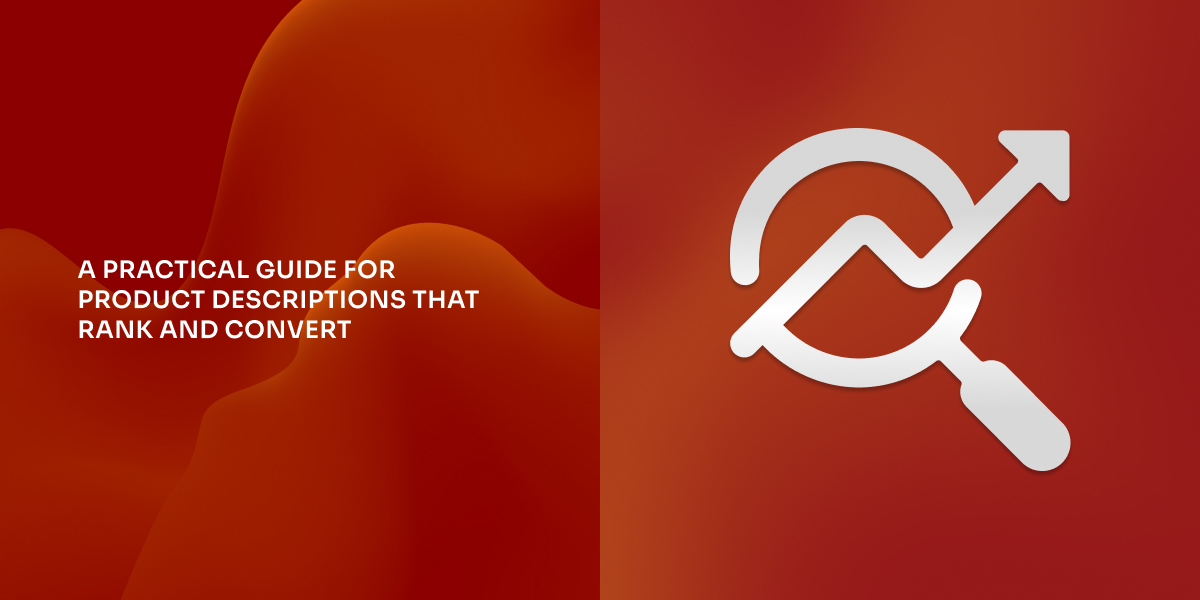A practical guide for product descriptions that rank and convert

A writer-marketing assistant with a background in sociology and research, Alyanna is part of the marketing team at 1902 Software. As one of the newer members, she brings a fresh perspective and a growing curiosity about how technology helps businesses—especially in the B2B sector—connect with their audiences more effectively. She contributes to the team’s efforts in creating marketing materials and supporting initiatives for both 1902 Software and WriteText.ai.

SEO for product descriptions goes far beyond adding keywords. Product descriptions not only inform — they sell, persuade, and help your store rank. Yet many ecommerce businesses still treat them as an afterthought, copying manufacturer specs or reusing generic templates. The result? Duplicate content penalties, poor visibility, and lost revenue.
Optimizing product descriptions for SEO means combining keyword strategy, search intent, and technical structure to create content that appeals to both search engines and shoppers
Understanding the SEO foundation of product descriptions
Search engines evaluate product pages based on relevance, uniqueness, and user experience. Google’s algorithm looks beyond keyword matching — it understands context, entities (like brands or materials), and how well your content answers search intent.
A well-optimized product description balances three priorities:
- Discoverability. Helping search engines understand what the product is and who needs it
- Differentiation. Creating unique content that stands out from competitors and duplicate listings
- Conversion. Persuading visitors to buy once they land on the page
Technical elements like meta titles, headers, and internal links also guide how search engines interpret your page, so structure matters as much as writing. Mastering SEO product descriptions requires understanding both the creative and technical elements that drive visibility.
Primary and secondary keyword placement
Primary keywords should appear in key on-page elements — the product title, first 100 words, one H2 heading, and the meta description. For a running shoe, "men's trail running shoes" might be your primary target.
Placement strategy matters more than frequency. Front-load your main keyword in the opening sentence naturally: "These men's trail running shoes combine waterproof protection with aggressive traction for technical terrain." This signals relevance immediately without awkward repetition.
Secondary keywords and long-tail variations expand your semantic footprint. For the running shoe example, you might naturally incorporate terms like "trail grip technology," "waterproof hiking footwear," or "off-road running gear" into subheadings, bullet points, and supporting paragraphs. These variations help search engines understand the full scope of your product's relevance while matching different ways customers search for the same solution.
Avoid keyword density obsession. Modern SEO prioritizes context and natural language. If forcing a phrase disrupts readability, rephrase or skip it. Search engines penalize thin, over-optimized content faster than they reward keyword stuffing.
Leveraging entities for semantic richness
Entities are recognizable concepts like brand names, materials, or technologies that give search engines clearer context. For example, including “Gore-Tex membrane” or “Vibram outsole” in a hiking boot description helps Google understand your page’s topic more precisely.
When optimizing for AI writing for ecommerce tools, relevant entities might include "natural language processing," "Shopify integration," "WooCommerce compatibility," or "multi-language support." These terms create semantic relationships that improve topical authority.
Entity-rich descriptions also support voice search and AI-driven shopping assistants, which rely on structured understanding rather than keyword matching. When someone asks, "What waterproof hiking boots have Vibram soles?" search engines favor pages that explicitly mention both entities together.
Crafting unique content across product variants
Duplicate content remains one of ecommerce's biggest SEO challenges. When you sell the same shirt in five colors or three sizes, copying descriptions wholesale dilutes your rankings and confuses search engines about which page to prioritize.
The fix is variant-specific customization. For color variations, describe how each shade complements different styles or seasons. For size differences, explain fit considerations. Even small changes—"This navy blazer pairs perfectly with khaki chinos for business casual settings"—differentiate the page.
Businesses managing hundreds of SKUs face a scaling problem. Manual rewriting isn't feasible. This is where AI-generated product descriptions and scalable product description tools prove valuable. Modern product description writer platforms and product description software can generate unique variants by programmatically combining product attributes, customer use cases, and style guidelines. These tools effectively auto generate product descriptions while maintaining uniqueness across variants.
However, relying entirely on AI to generate product descriptions with zero human oversight often produces generic, feature-focused copy lacking brand voice. It's best to use AI for writing product descriptions when you couple it with configuration—set tone parameters, define style guidelines, and customize output settings to match your brand.
Many businesses now rely on AI product descriptions to handle the bulk of content creation, but the smartest implementations build customization into the workflow itself. Advanced platforms offer multiple configuration options—from tone and length controls to audience targeting and feature prioritization. Understanding how to rewrite AI-generated product descriptions for better readability becomes easier when the initial output is already closer to your brand voice, requiring only final touches like personality injection, objection handling, and benefit emphasis rather than complete rewrites.
Strategic internal linking
Internal linking distributes authority across your site and helps search engines understand relationships between pages.
For example, when listing a camera, link to:
- Category pages (e.g., "Mirrorless Cameras")
- Related accessories (lenses, memory cards)
- Buying guides or tutorials
Use descriptive anchor text that includes target keywords naturally: "Browse our full collection of mirrorless camera lenses" or "Compare DSLR vs mirrorless cameras" rather than generic "click here" links. This passes contextual relevance to the linked page.
Avoid overlinking and limit to three to five relevant links per page to maintain focus and clarity.
Implementing FAQ schema and on-page FAQs
Adding FAQ sections to product pages helps answer buyer questions while improving your chances of appearing in featured snippets. Use FAQ schema markup so search engines can display your responses directly in search results.
For example:
- "How long do these trail running shoes last?"
- "Are these shoes true to size or should I size up?"
- "Can I use these for road running or only trails?" "Do these running shoes have arch support?"
Keep answers concise (40-60 words) but complete. Link to detailed policies or guides when appropriate, creating internal linking opportunities while satisfying user intent quickly.
Optimizing product description length and structure
There's no universal ideal product description length, but context matters. Simple products (phone cases, basic apparel) function well with 150-300 words. Complex items (electronics, specialized equipment) benefit from 400-800 words covering specs, use cases, and comparisons.
Prioritize information hierarchy:
- Hook (20-30 words). Lead with the primary benefit and keyword.
- Key features (bullet points). Scannable specs and differentiators.
- Detailed explanation (150-400 words). How it works, who it's for, why it's better.
- Social proof. Reviews, ratings, or usage stats.
- Urgency/CTA. Clear next step.
Keep paragraphs short (2–3 sentences) and headings descriptive to make the content easy to skim.
Avoiding common SEO pitfalls
- Thin content. Pages with only manufacturer specs or bare-bones descriptions signal low value to search engines. Add context, benefits, and use cases to reach meaningful depth.
- Keyword cannibalization. Occurs when multiple pages target identical keywords. If five product variants all optimize for "leather wallet," they compete against each other. Differentiate with long-tail modifiers: "minimalist leather wallet," "RFID-blocking leather wallet," "vintage brown leather wallet."
- Neglecting mobile optimization. Over 60% of ecommerce traffic comes from mobile devices. Ensure descriptions render cleanly on small screens—short paragraphs, clear headings, and fast-loading images.
Scaling SEO-optimized descriptions efficiently
Once your SEO framework is solid, the next step is scaling it efficiently. Managing hundreds of product pages manually isn’t sustainable — smart ecommerce teams use a mix of automation and review.
Effective workflows include:
- Template frameworks. Define reusable structures (hook, features, benefits, specs) that maintain consistency while allowing customization
- Attribute-based generation. Use product description software that dynamically combines attributes (size, color, material) into unique variants through automated product descriptions.
- Batch workflows. Leverage tools that support batch product description creation, allowing bulk edits while preserving unique elements per SKU. These systems can automate product descriptions at scale without sacrificing quality.
- Quality checks. Implement review processes for AI write product descriptions outputs, ensuring accuracy and brand alignment
The goal isn’t replacing creativity — it’s automating repetitive work so your team can focus on strategic products that drive the most traffic. AI writing for ecommerce works best when it handles volume while humans refine strategy and brand voice.
Measuring SEO performance for product pages
Track metrics that correlate with business outcomes:
- Organic traffic growth: Are product pages attracting more visitors from search?
- Keyword rankings: Do target terms show improving positions?
- Engagement metrics: Time on page, scroll depth, and bounce rate indicate content quality
- Conversion rate: SEO-optimized descriptions should ultimately drive sales
Use Google Search Console to identify underperforming pages with impressions but low clicks—these need improved titles or meta descriptions. Pages with clicks but poor conversion may have strong SEO but weak persuasive copy.
Creating SEO-optimized product descriptions isn't a one-time task—it requires ongoing testing and refinement. By strategically placing keywords, leveraging semantic entities, and creating unique variant content, you build product pages that rank and convert.
Whether managing descriptions manually or using AI for product descriptions to scale, the principles remain constant: clarity, uniqueness, and genuine value. Tools like WriteText.ai help businesses maintain this balance at scale, offering the customization controls needed to produce SEO-optimized content.